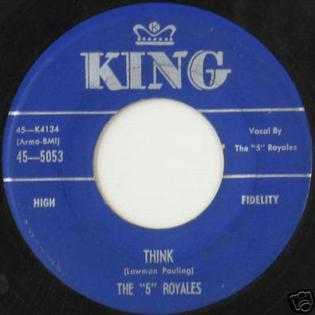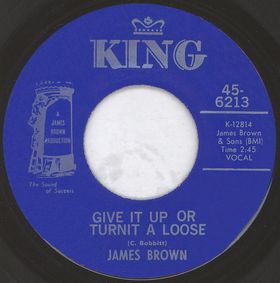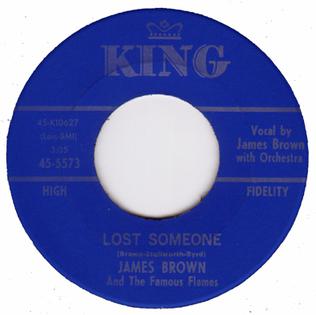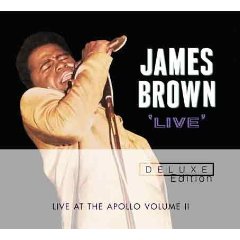Related Research Articles

"Papa's Got a Brand New Bag" is a song written and recorded by James Brown. Released as a two-part single in 1965, it was Brown's first song to reach the Billboard Hot 100 Top Ten, peaking at number eight, and was a number-one R&B hit, topping the charts for eight weeks. It won Brown his first Grammy Award, for Best Rhythm & Blues Recording.
"Soul Power" is a song by James Brown. Brown recorded it with the original J.B.'s and it was released as a three-part single in 1971. Like "Get Up Sex Machine" and other hits from this period it features backing vocals by Bobby Byrd. It charted #3 R&B and #29 Pop.
"There Was a Time" is a song written and performed by James Brown.

"Mother Popcorn " is a song recorded by James Brown and released as a two-part single in 1969. A #1 R&B and #11 Pop hit, it was the highest-charting of a series of recordings inspired by the popular dance the Popcorn which Brown made that year, including "The Popcorn", "Lowdown Popcorn", and "Let a Man Come In and Do the Popcorn".

"Think" is a rhythm and blues song written by Lowman Pauling and originally recorded by his group The "5" Royales. Released as a single on King Records in 1957, it was a national hit and reached number nine on the U.S. R&B chart.

"Get on the Good Foot" is a funk song performed by James Brown. It was released in 1972 as a two-part single that charted #1 R&B and #18 Pop. It also appeared on an album of the same name released that year. Partly due to the unwillingness of Brown's record labels to certify sales of his previous hits, "Get on the Good Foot" was his first gold record. Billboard ranked it as the No. 99 song for 1972.

"Give It Up or Turnit a Loose" is a funk song recorded by James Brown. Released as a single in 1969, the song was a #1 R&B hit and also made the top 20 pop singles chart. "Give It Up or Turnit a Loose" appeared as an instrumental on the Ain't It Funky (1970) album, removing Brown's vocals and adding guitar overdubs, while the vocal version was released onto Soul Classics (1972).

"Make It Funky" is a jam session recorded by James Brown with The J.B.'s. It was released as a two-part single in 1971, which reached No. 1 on the U.S. R&B chart and #22 on the U.S. Pop chart.

"Doing It to Death", also known as "Gonna Have a Funky Good Time", is a funk song recorded by The J.B.'s featuring James Brown. A 10-minute, two-part version of "Doing It to Death" was included on a J.B.'s album of the same name. The complete, unedited and nearly 13-minute-long original recording of the song was first issued on the 1995 J.B.'s compilation Funky Good Time: The Anthology. Performances of the song also appear on the albums Live at Chastain Park and Live at the Apollo 1995.

"Lost Someone" is a song recorded by James Brown in 1961. It was written by Brown and Famous Flames members Bobby Byrd and Baby Lloyd Stallworth. Like "Please, Please, Please" before it, the song's lyrics combine a lament for lost love with a plea for forgiveness. The single was a #2 R&B hit and reached #48 on the pop chart. According to Brown, "Lost Someone" is based on the chord changes of the Conway Twitty song "It's Only Make Believe".
"Bewildered" is a popular song written in 1936 by Teddy Powell and Leonard Whitcup. It was a 1938 hit for Tommy Dorsey and His Orchestra.
"I'll Go Crazy" is a rhythm and blues song recorded by James Brown and The Famous Flames. Released as a single in 1960, it was Brown's fourth R&B hit, charting at #15. Brown and the Flames also performed it as the first song on their 1963 album Live at the Apollo.

Live at the Apollo, Volume II is a 1968 live double album by James Brown and The Famous Flames, recorded in 1967 at the Apollo Theater in Harlem. It is a follow-up to Brown's 1963 recording, Live at the Apollo. It is best known for the long medley of "Let Yourself Go", "There Was a Time", and "I Feel All Right", followed by "Cold Sweat", which document the emergence of Brown's funk style. It peaked at #32 on the Billboard albums chart. Robert Christgau included the album in his "basic record library" for the 1950s and 1960s.
"Maybe the Last Time" is a song written by James Brown and recorded by Brown and the Famous Flames in 1964. It was released as the B-side of "Out of Sight" and was also included on the Out of Sight album. Brown described it as "a heavy gospel-based number, all about appreciating friends and everything while you can because each time you see somebody may be the last time, you don't know." It was the last studio recording Brown made with the Famous Flames, although the singing group continued to perform live with him for several more years.
Live at the Garden is a 1967 live album by James Brown and The Famous Flames. It was recorded on January 14, 1967 in the middle of a ten-day engagement at the Latin Casino in Cherry Hill, New Jersey - Brown's first at an upscale nightclub. Like most of Brown's live albums, overdubbed crowd noise was added to the original recording for its LP release. It included one new song, "Let Yourself Go", which was recorded after hours at the casino; it appeared on the album disguised as a live recording. Although Live at the Garden peaked at #41 on the Billboard album chart, it came to be overshadowed in Brown's catalog by his next live album, Live at the Apollo, Volume II, recorded later the same year and released in 1968.
"You've Got the Power" is a song written by James Brown and Famous Flames member Johnny Terry and recorded by Brown with Bea Ford as a duet in 1960. Released as the B-side of Brown and the Famous Flames' hit recording of "Think", it also charted, reaching #14 R&B and #86 Pop. It was Brown's first recorded duet and his first hit B-side. Brown briefly performs the song in a medley on his 1963 album Live at the Apollo.
"I Don't Want Nobody to Give Me Nothing " is a funk song written and recorded by James Brown. It was released as a two-part single, which charted #3 R&B and #20 Pop. The single version of the song did not receive an album release until Foundations of Funk: A Brand New Bag, but a live recording was included on Brown's 1970 album Sex Machine.
"Ain't That a Groove" is a song written by James Brown and Nat Jones. Brown recorded it in 1965 with the female vocal group The Jewels and a studio band arranged and conducted by Sammy Lowe. Released in edited form as a two-part single in 1966, it charted #6 R&B and #42 Pop. The unedited studio recording of the song was included in the 1991 box set Star Time.
"Don't Be a Dropout" is a song written by Burt Jones and recorded by James Brown. It was Brown's first attempt at a socially conscious song, encouraging teenagers to stay in school. Released as a single in 1966, it charted #4 R&B and #50 Pop. It also appeared on the album Sings Raw Soul. Bobby Byrd, Vicki Anderson, and The Jewels contribute backing vocals. The song led to Brown meeting with Vice President Hubert Humphrey, who had been working on a stay-in-school program of his own.
"Bring It Up", also known as "Bring It Up ", is a song recorded by James Brown. It was released as a single in 1967 and charted #7 R&B and #29 Pop. It also appeared on the album James Brown Sings Raw Soul. An unedited version of the song was released on the 1991 box set Star Time.
References
- ↑ White, Cliff (1991). "Discography". In Star Time (pp. 54–59) [CD booklet]. New York: PolyGram Records.
- ↑ Leeds, Alan, and Harry Weinger (1991). "Star Time: Song by Song". In Star Time (pp. 46–53) [CD booklet]. New York: PolyGram Records.
- ↑ Leeds, Alan (2009). Live at the Garden: Expanded Edition [CD booklet]. New York: Universal Records.
- ↑ George, Nelson. The Death of Rhythm and Blues . Pantheon Books, 1988, p. 109.
- ↑ Smith, R.J. (2012). The One: The Life and Music of James Brown, 175. New York: Gotham Books.